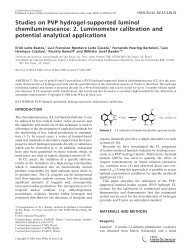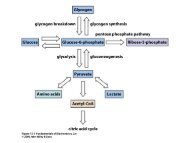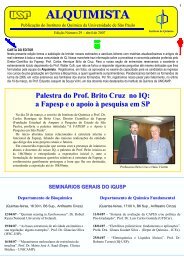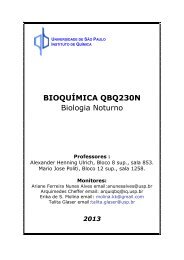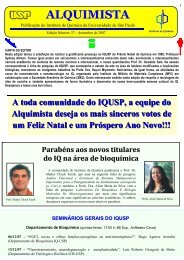Direct UV photocrosslinking of poly(N-vinyl-2-pyrrolidone) (PVP) to ...
Direct UV photocrosslinking of poly(N-vinyl-2-pyrrolidone) (PVP) to ...
Direct UV photocrosslinking of poly(N-vinyl-2-pyrrolidone) (PVP) to ...
You also want an ePaper? Increase the reach of your titles
YUMPU automatically turns print PDFs into web optimized ePapers that Google loves.
L.C. Lopérgolo et al. / Polymer 44 (2003) 6217–6222 6221Fig. 3. Effect <strong>of</strong> irradiation dose and <strong>PVP</strong> concentration on the (A) swelling ratio at equilibrium, Q; (B) the number-average molecular weight betweencrosslinks, M c ; (C) crosslinking density, r x and (D) mesh size, j: (-B-) 40 mg/ml; (-X-) 60 mg/ml; (-O-) 80 mg/ml; (-P-) 120 mg/ml; (-V-) 200 mg/ml.needed (see Fig. 1). Hence, for such cases, mesh size wasfound <strong>to</strong> be around 4–6 nm.The swelling ratio at equilibrium depicts the maximumamount <strong>of</strong> water the hydrogel can hold, and again this is afunction <strong>of</strong> concentration and dose (Fig. 3(A)). Thisparameter is especially important in applications wheregels are used <strong>to</strong> absorb exudates, like wound dressings anddrug delivery devices. In the last case, the augment <strong>of</strong> meshsize due swelling is the prime control <strong>of</strong> delivery rate.The mechanical properties <strong>of</strong> the hydrogel were alsoanalyzed. The tensile strength ðT s Þ and elongation at breakðE b Þ were determined for a typical membrane used fordressing (3 mm thick) irradiated with 12.7 J, as a function <strong>of</strong><strong>PVP</strong> concentration. Table 1 lists the values found.While elongation at break did not present a significantvariation, the tensile strength was optimum for <strong>PVP</strong>concentration <strong>of</strong> 80–90 mg/ml, decreasing at higherconcentration. This can be explained by reviewing Fig.1(B), where it is clear that the gel fraction decreases athigher concentration, therefore compromising its mechanicalproperties.As compared <strong>to</strong> membranes produced by high-energyradiation, where tensile strength was found <strong>to</strong> be 0.02 MPafor the same concentration [15], the membrane herereported is ca. 30% weaker. However, even with thisdecrease in mechanical quality, the membrane still is quitestrong <strong>to</strong> be handled. Besides, other types <strong>of</strong> reinforcementmay be applied <strong>to</strong> suite its use [16].Table 1Mechanical properties <strong>of</strong> the hydrogel produced by <strong>UV</strong> radiation<strong>PVP</strong> conc.(mg/ml)gð%Þr x(10 25 mol/cm 3 )T s(10 23 MPa)E b(%)Fig. 4. Colony suppression curves <strong>of</strong> the hydrogel membranes produced bydifferent <strong>UV</strong> doses.[<strong>PVP</strong>] ¼ 80 g/l in water at room temperature. (—S—)288 J; (—A—) 389 J; (—W—) 777 J; (—K—) 1150 J; (—X—) negativecontrol (PVC); (—O—) positive control (phenol).80 84.5 ^ 0.6 3.47 ^ 3.4 12.3 ^ 2.1 54.5 ^ 5.190 – – 13.0 ^ 1.0 55.3 ^ 1.5100 – – 11.6 ^ 1.0 60.0 ^ 5.0120 80.9 ^ 2.1 3.36 ^ 5.3 10.2 ^ 1.2 62.0 ^ 6.9200 75.9 ^ 3.4 2.59 ^ 5.1 9.6 ^ 0.9 61.9 ^ 5.0Irradiation made on a quartz mold by pen-type lamp; irradiation dose1.8 kJ.


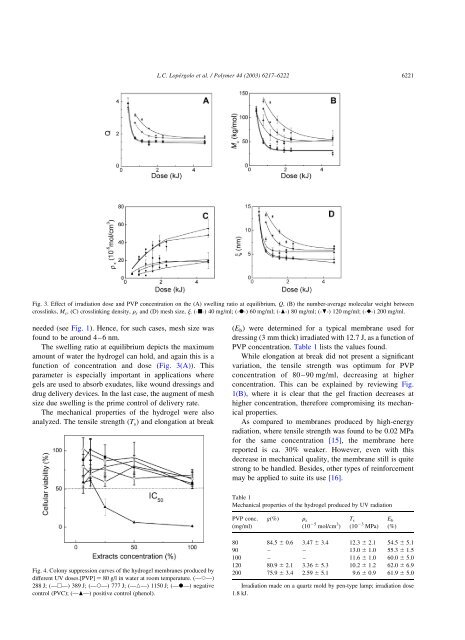
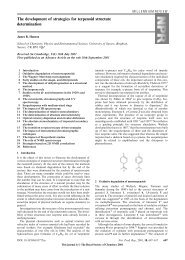
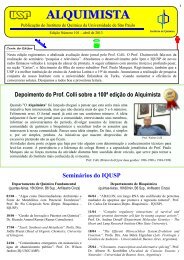
![PE]+ + N. Fragmentação por clivagem sigma](https://img.yumpu.com/50134385/1/180x260/pe-n-fragmentaaao-por-clivagem-sigma.jpg?quality=85)
